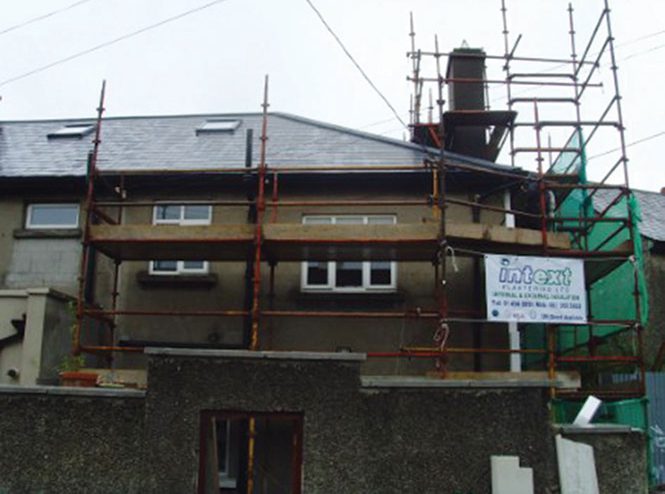
Plastering is a specialised trade and like all skills takes years to master. However, it is sometimes referred to as the ‘forgotten trade’ as apprentices opt for the more ‘glamourous’ work of electrical, carpentry, plumbing or block laying.
Plastering is equally as important as any of these trades and a plasterer is a tradesman who works with plaster, such as forming a layer of plaster on an interior wall or plaster decorative mouldings on ceilings or walls. The process of creating plasterwork, called plastering, has been used in building construction for centuries.
When a person enters their newly built home, the first sight they see is their walls perfectly plastered, but unfortunately at times, this is a skill that is taken for granted.
The city of Dublin has a very long history in the skill of plastering where decorative plasterwork developed to a high level from Georgian times. With the current decline in new building, the emphasis during the next decade will be on reconstruction, maintenance and conservation of existing building stock and expertise in plastering will once again be in strong demand.
Some people are passionate about their profession and one of these is John Kerrigan who owns and operates two businesses Intext Plastering Ltd and Intext Mouldings.
John is the President of the Plastering Contractors Association, which is one of the oldest boards in the CIF here in Ireland and through his many years of experience in the industry, he has helped improve the standard of the trade and also make it more appealing for apprentices thinking of entering a plasterer’s career.
Not one to rest on his laurels, John sits on an advisory panel in the Dublin Institute of Technology (DIT) on Bolton Street as well as a Solas (FAS) board where they try to implement ways of improving the training for up and coming plasterers.
“Through my work as president of the PCA, I was asked onto the advisory panel at Bolton Street. It is a role that I enjoy as it is a way of giving something back,” said John.
“Plastering is a very skilled trade and probably doesn’t receive the recognition that it deserves, but this is something that we are keen to change.”
John established Intext Plastering Ltd in 1993 and he has experienced the highs and lows of business throughout the good and bad times.
He revealed that business is just starting to pick up again following the latest recession to hit the country.
“I’ve noticed a bit of a pick up over the last 18 months or so. We’re kept going and have a few jobs ongoing at the moment, including a 3,000sq metre crèche in Clonee, which is good, but you would always like to be busier,” added John whose company is based in the Greenhills Industrial Estate, Walkinstown, Dublin 12.
“We’ve picked up a lot of experience over the years and are able to carry out a wide variety of projects in the plastering sector including insulation, internal and external. I’ve travelled all over Europe looking at the different standards of plastering, while also learning different aspects of recycling plasterboards and other materials.”
John added that over the years he has found that the best form of advertisement is his work and through word of mouth.
“If a customer is happy with the work, then they will recommend us to other people and I think that is the best form of advertisement that you can have.”
John could be described as something of an innovator in the plastering world as in 1996, he established Intext Mouldings Ltd, having invented his own type of concrete overcill, which has been patented both here in Ireland and the U.K.
“We have cornered a niche in the market and this product was produced after a great deal of research over a long period. We are NSAI certified and have the Fetec level 5 for Thermal Insulation.”
Intext Mouldings Ltd has carried out a number of projects over the years with their product being manufactured in Ireland and sold throughout this country and the U.K.
“We have supplied and fitted for a number of large contracts including the Four Seasons hotel for Crampton where we installed 10km of cornice in the bedrooms alone, houses and apartments for Sorohan brothers and Cosgrave’s to name a few.”
Customers don’t have to wait on an order as there is a constant stock pile there to cater for their needs.
The concrete overcill went under stringent independent testing before being placed on the market including tests for thermal conductivity, thermal resistance, thermal bridging, pull off test, moisture absorption and hammer test.
In order to replace a concrete cill and maintain the original feature, internal and external blockwork would have to be removed. This is both impractical and uneconomical, but there is now a solution to this.
“The Concrete Overcill solves this problem and eliminates any unnecessary structural work or the use of non-traditional alternatives such as metal. When insulation is fixed in place, the concrete Overcill is measured and cut to size on site. A thin layer of insulation can be applied to the existing cill to reduce cold bridging. The Concrete Overcill is then placed onto the existing cill and over the insulation using appropriate adhesive.
“There are many advantages including that it is compatible to all EWI systems. It is NSAI approved and maintains the integrity of the building.
“The concrete overcill is equally as durable as the existing concrete cill. There is an option to leave natural or paint and it is easily cut to the required size. There is no steel involved and this means no corrosion, while it is fire resistant and is also a recyclable material.”
Contact Details:
Intext Mouldings Ltd
Unit 24
Greenhills Industrial Estate
Walkinstown
Dublin 12
Phone 01 4946991
Mobile 087 2605933
E-mail
[email protected]
Taken from Building Ireland magazine, May/June 2016, Vol 2, No 2